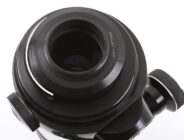Heinz Kilfitt Munchen Pan-Tele-Kilar 300mm F/4
akaZoomar Muenchen Pan-Tele-Kilar 300mm F/4
Super telephoto prime lens • Film era • Discontinued
- Announced:
- · 1956
- Production status:
- ● Discontinued
- Country of design:
- · FRG (Federal Republic of Germany)
- Original name:
- · Heinz Kilfitt München Pan-Tele-Kilar 1:4 f=300mm ○○○
- · Kilfitt München Pan-Tele-Kilar 1:4 f=300mm
- · ZOOMAR MUENCHEN Pan-Tele-Kilar 1:4 f=300mm
- Class:
- · Slow 6x6 medium-format super telephoto prime lens
- · Professional model (Top class)
Specification
| Optical design: | |
| Medium format 6x6 | |
| 300mm | |
| F/4 | |
| 4 elements | |
| Interchangeable mount | |
| Diaphragm mechanism: | |
Diaphragm type: | Preset |
Aperture control: | Preset ring + Aperture ring |
| 16 (sixteen) | |
| Focusing: | |
| <No data> | |
| <No data> | |
Focusing modes: | Manual focus only |
Manual focus control: | <No data> |
| Physical characteristics: | |
| <No data> | |
| <No data> | |
| Accessories: | |
| Screw-type 88mm | |
| Screw-type round | |
| <No data> |
Sources of data
- Kilfitt lenses price list by Kling Photo (September 1963).
- Kilfitt price-list and technical data (in German) (October 1961).
- Zoomar Liste 370 (July 1970).
Manufacturer description #1
Duo-Range, high speed telephoto lens of unique design with an extreme focusing range from infinity to 5 1/2 feet, giving full coverage even to 2 1/4 x 2 1/4" format. Parallel focus with left and right focusing knobs and detachable fast-focus lever. Helical extension sets close-up focusing range (10 to 5 1/2 ft.) of lens. Built-in tripod socket in rotatable mount with set screw. Overlapping locking ring for use with 'an' flange adapters and reflex housings. Supplied with deep, screw-in lens shade and front lens cover.
Manufacturer description #2
The new lenses PANO and PANSO replace the well known Pan Tele Kilars which were prefered in the past by expert photographers, cinematographers, explorers, hunters, scientists and reporters. In order to improve the all round versatility of these lenses some new features have been developed:
- Adaptable to single lens reflex 35 mm and 2 1/4 X2 1/4" as well as motion picture cameras.
- High optical quality, brilliance, resolving power and color correction.
- Large and easily readable scales.
- Red index for infra-red exposures.
- Preset diaphragm.
- Patented rubber lining on focusing and distance rings.
The PANSO model is equipped with a quick focusing lever and an additional extension permitting close-up shots at the distance of 1.4 meters (3.3').
The PANO model if necessary can be adapted with the fast focusing device.
From the Popular Photography - ND magazine (January 1957)
Kilfitt-Munchen have completely redesigned a number of their very popular lenses. The 300-mm Tele-Kilar f/5.6 is now the 300mm Tele-Kilar f/4 with preset diaphragm, filter slot in the rear of the mount near the camera flange, additional built-in extension enough to focus down to about 6 1/2 feet, and a very rapid focusing system employing a rack-and-pinion with high gear ratio operated by means of a long panning lever. The 400-mm Fern-Kilar, now with a maximum aperture of f/4, shares the same lens-mount features as the 300-mm Tele-Kilar.
From the SPIE-glass (August 1967)
Improved versions of the famed 300mm KILFITT PAN-TELE-KILARS have recently been introduced by ZOOMAR, Inc. The new "PANO" and "PANSO" 300mm F/4 telephoto lenses now offer the news, science and sports photographer the additional advantages of:
(1) ... adaptable to 35mm and 2 1/4 by 2 1/4 in. SLR, and 16mm "C" mount motion picture cameras.
(2) Close focusing ranges of 3 1/2 ft. for "PANSO", and 5 1/2 ft. for "PANO".
(3) A quick focusing lever for the "PANSO" model.
(4) Large, easily-read scales.
(5) Red index for infrared photography.
(6) Preset diaphragm.
(7) Built-in sunshade and filter holder with slot for 2 by 2 in. gelatin filter.
(8) Patented rubber grips for focusing and distance rings.
and (9) Built-in tripod sockets.
From the editor
There were 3 versions of the Pan-Tele-Kilar 300/4:
- Codeword "Pante" (1956-1966) - Heinz Kilfitt München - the first version that used "an-" adapters. Both the distance scale and the aperture scale in silver finish. The Kilfitt price-list and technical data (in German) (October 1961) indicates the following specifications: closest focusing distance: 1.8m, weight: 2000g, maximum diameter: 98mm, length: 215mm;
- Codeword "Panso" (1966-1979) - Zoomar - the all-black second version that used "we-" adapters. The Zoomar Pan-Tele-Kilar 1:4/300 instructions indicates the following specifications: closest focusing distance: 1.4m, maximum magnification: 1:3, weight: 1920g, maximum diameter: 98mm, length: 215mm. The Zoomar Liste 370 (July 1970) indicates slightly different dimensions: maximum diameter: 95mm, length: 225mm;
- Codeword "Pano" (1966-1977) - Kilfitt München - the all-black third version that used "we-" adapters. Without focusing wheels and focusing lever. Focusing by rotating the front section of the barrel. The Zoomar Pan-Tele-Kilar 1:4/300 instructions indicates the following specifications: closest focusing distance: 1.7m, maximum magnification: 1:4, weight: 1560g, maximum diameter: 98mm, length: 215mm.
***
For the list of "an-" adapters for the "Pante", please refer to the page dedicated to the Fern-Kilar 400/5.6 lens.
For the "Panso", the Zoomar Liste 370 (July 1970) lists "we-" adapters for the following cameras: Cine Reflex mit C-Gewinde, Cine Reflex mit D-Gewinde, Arriflex, Gewinde M42x1, Exakta/Exa/Topcon, Alpa, Canon, Contarex, Icarex, Leicaflex, Minolta, Nikon, Olympus, Petri, Praktina, Revue Konica Auto-Reflex, as well as adapters for the Kilarscope, Kilarflex, Visoflex II and III, Hasselblad 1000 F, Praktisix/Pentacon-six, Rittreck/Revue-six, Kalimar, Bronica, Rollei SL 66.












